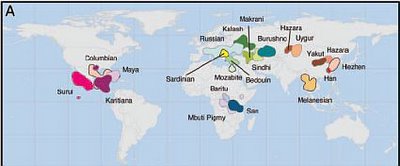(Last Update: Oct 17)
Here is a result of an ADMIXTURE run of a few populations from Eurasia (left to right: Turks, Armenians, Georgians, followed by a mix of Uygur, Mongolians, Yakut, Hezhen in no order), combining the HGDP dataset with that of Behar et al. (2010).

It's more of a test, rather than a final result, as I've just finished integrating the two datasets, but it's a nice comparison of a wide assortment of linguistic families.
Notice Turks and Armenians being quite similar to each other, (green+blue), although Turks are differentiated by the presence of an east Eurasian component (5.5%). On the basis of uniparental markers, five years ago, I estimated this component as 6.2% which seems to be right on the money. In the combined Armenian/Georgian sample this admixture is only 0.14% and as can be seen is limited to a handful of Georgian individuals.
It is interesting that Georgians belong semi-uniquely to the green cluster. Turks' non-Mongoloid ancestors were Indo-European speaking like the Armenians still are. It would be tempting to see in the blue-green contrast an Indo-European/Caucasian one, especially as the Caucasoid component further east seems to be mainly blue, in agreement with the idea that it was Indo-Europeans (in particular mainly Iranic speakers) who brought Caucasoid genes to the heartland of Asia.
UPDATE I (Oct 17):
Moving to the north, we see (left-to-right) Han (red), Hungarian/Belorussian (blue), Chuvash (first red "step"), Uzbek (second red "step"). Unlike the Turks, the Hungarians, who also speak a language that came from the east, seem to lack a noticeable east Eurasian component.
Their linguistic conversion was one of elite dominance, where a handful of Mongoloid and quasi-Mongoloid upper echelons left their language but not their genes:
According to his observations, the “overlords” were characterized by Turanid, Uralian and Pamir race elements and also by certain long-headed components. The “middle layer” or “warriors’ layer”, however, showed an anthropological profile distinctly different from that of the overlords. It was essentially constituted by Mediterraneans, Nordoids (who might also have been tall robust Mediterraneans) and Pamir component while the absence of Turanid and Uralian race characteristics was remarkable. As regards the third layer, the so-called “common folk”, they were dominated, just as the middle layer was, by Mediterranean and Nordoid elements but, in addition, the Cromagnoid ones were also significant.



